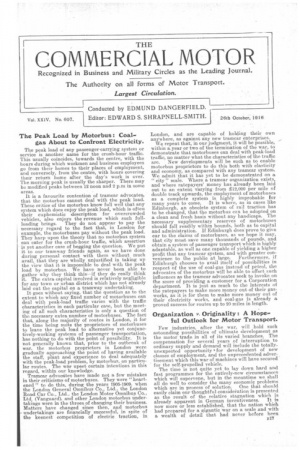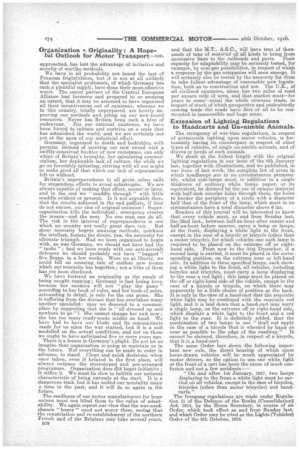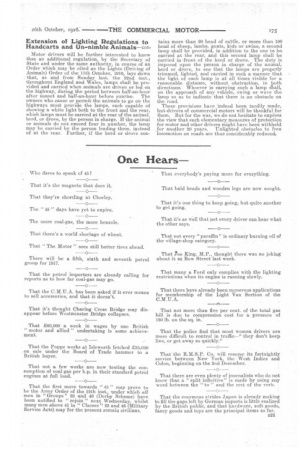The Peak Load by Motorbus : Coalgas About to Confront Electricity.
Page 1

Page 2

Page 3

If you've noticed an error in this article please click here to report it so we can fix it.
The peak load of any passenger-carrying system or service is another name for the crush-hour traffic. This usually coincides, towards the centre, with the hours during which workmen and business employees go from their homes to their places of employment, and conversely, from the centre, with hours covering their return home after the day's work is over. The morning peak is usually the sharper. There may be modified peaks between 12 noon and 2 p.m in some areas.
It is a favourite contention of tramcar advocates, that the motorbus cannot deal with the peak load. These critics of the motorbus know full well that any system which does enjoy the peak load, which is often their euphemistic description for overcrowded vehicles, also enjoys the revenue which such full.. loading brings. They do not appear to pay the necessary regard to the fact that, in London for example, the motorbuses pay without the peak load. They harp upon the theory that no motorbus system can cater for the crush-hour traffic, which assertion is yet another case of begging the question. We put it to our tramway friends again, as we have done during personal contact with them without much avail, that they are wholly unjustified in taking up the view that it is impossible to deal with the peak load by motorbus. We have never been able to gather why they think this—if they do really think rt. The extra capital involved is relatively negligible for any town or urban district which has not already laid out the capital on a tramway undertaking. It goes without saying,. that the question as to the extent to which any fixed number of motorbuses can deal with peak-load traffic varies with the traffic characteristics in each particular case, but the meeting of all such characteristics is only a question of the necessary extra number of motorbuses. The fact that, along the majority of routes in London, it for the time being suits the proprietors of motorbuses to leave the peak load to alternative yet conjunctively-working systems of passenger transportation, has nothing to do with the point of possibility. It is not generally known that, prior to the outbreak of war, the motorbus proprietors in London were gradually approaching the point of having available the staff, plant and experience to deal adequately with the peak-load problem, by motorbus, on particular routes. The war upset certain intentions in this regard, within our knowledge. Tramcar advocates have made not a few mistakes in their criticisms of motorbuses. They were " heartened " to do this, during the years 1905-1909. when the London General Omnibus Co. Ltd., the London Road Car Co., Ltd., the London Motor Omnibus Co., Ltd. (Vanguard). and other London motorbus undertakings were in the throes of changing their business. Matters have changed since then, and motorbus undertakings are financially successful, in spite of the keenest competition of electric traction, in London, and are capable of holding their own anywhere, as against any new tramcar enterprises.
We repeat that, in our judgment, it will be possible, within &year or two of the termination of the war, to demonstrate that motorbuses can deal with peak-load traffic, no matter what the characteristics of the traffic are. New developments will be such as to enable motorbus proprietors to do this both with elasticity and economy, as compared with any tramcar system. We admit that it has yet to be demonstrated on a " city " scale. Where a tramcar organization exists, and where ratepayers' money has already been laid out to an extent varying from 212,000 per mile of double track upwards, the employment of motorbuses as a complete system is highly improbable for many years to come. It is where, as in cases like Edinburgh, an obsolete system of rail traction has to be changed, that the motorbus can be adopted on a clean and fresh basis without any handicaps. The necessary supplementary reserves of motorbuses should fall readily within bounds, both as to capital and administration. If Edinburgh does prove to give ear to the claims of motorbuses, as we hope it. may, that city must save many thousands of pounds,. and obtain a system of passenger transport which is highly adaptable, as well as one capable of yielding a higher profit that any tramcar system, and with greater convenience to the public at large. Furthermore, if Edinburgh chooses to avail itself of possibilities in respect of the use of coal-gas instead of petrol, the advocates of the motorbus will he able to offset such influences as the tramcar advocates seek to invoke on the score of providing a customer for a Corporation department. It is just as much to the interests of the ratepayers to make more money out of their gasworks, as it is for them to make more money out of their electricity works, and coal-gas is already a proved success for routes up to 20 miles in length.
Organization v. Originality : A Hope-. ful Outlook for Motor Transport.
Few industries, after the war, will hold such astounding possibilities of ultimate development as the motor trade in all of its varied branches. The compensation for several years of interruption to ordinary supply and demand will include the totallyunexpected opportunity 'for development of new classes of employment, and the unprecedented advertisement which this war of machines will have secured for the self-propelled vehicle.
The time is not quite yet to lay down hard and fast programmes for the entirely-new circumstances which will supervene, but in the meantime we shall all do well to consider the many economic problems which are in process of solution. One that should easily claim our thoughtful consideration is presented as the result of the relative stagnation which is already apparent in German inventiveness. It is now more or less established, that the nation which had prepared for a gigantic war on a scale and with a wealth of detail that had never before been
Organization v. Originality : A Hopeful Outlook for Motor Transport—con.
approached, has lost the advantage of initiative and novelty of warlike methods.
We have in all probability not heard the last of Prussian frightfulness, but it is not at all unlikely that the specialist professors., of which Germany has such a plentiful supply, have done their most-effective worst. The senior partner of the Central European Alliance had foreseen and prepared to so amazing an extent, that it may be assumed to have organized all their inventiveness out of existence, whereas we in this country, totally unprepared, are hourly improving our methods and piling up our new-found resources. Never has Britain been such a hive of endeavour. For our national existence, we have been forced to initiate and contrive on a scale that has astonished the world, and we are certainly not yet at the apex of our industrial effort.
Germany, organized to death and bedridden with permits, instead of meeting our new sword with a swiftly-conceived buckler of new resistance, can only whine of Britain's brutality, her calculating commercialism, her deplorable lack of culture, the while we go on feverishly initiating, striving with all our might to make good all that which our lack of organization left us without.
Britain's unpreparedness in all great crises calls for stupendous efforts to avoid catastrophe. We are always capable of making that effort, sooner or later, and in the end we "muddle through" with little miteldle evident or present. Is it not arguable then, that the results achieved in the end palliate, if they do not excuse, our sins of original omission? Superorganization kills the individual ; emergency creates the means—and the men. No one man can do all. The risk in the interval of unpreparedness is one which no country not really great dare run. But sheer necessity begets amazing methods, quickens the intellect, fosters the desire, yea, the necessity for ultimate triumph. Had we been organized to begin with, as was Germany. we should not have had the " tanks " ; had we been ready with our anti-aircraft defences we should probably not have " bagged " five Zepps, in a few weeks. -Were we at liberty, we could tell an amazing. tale of endless new means which our necessity has begotten ; not a tithe of them has yet been disclosed.
We have fostered an originality as the result of being caught napping ; Germany is fast losing hers, because her enemies will not "play the game" according to her book of rules, and her book of rules, astounding in detail, is only for the one game. She is suffering from the disease that has overtaken many another specialist : may we descend to a commonplace by suggesting_that she is "all dressed up and nowhere to go " ? She cannot change her suit now ; she has too many ready-made misfits on hand. We have had to have our khaki and its concomitants made for us since the war started, but it is a suit modelled on the actual conditions, and not on those we ought to have anticipated five or more years ago. There is a lesson in Germany's plight. Do not let us imagine that organization is going to maintain us in the future. Not everything can be made to order in advance, to stand. Clean and quick decisions, when 'once taken, even if belated in the first place, will always outpace the stereotyped and pre-arranged programme. Organization does riot beget initiative ; it stifles it. We must b:e slow. to belittle our national characteristic of being unready at the start. It is a dangerous trait, but it has suited our mentality many a time in the past, and it will do so again in the future.
The readiness of our motor manufacturers for huge output must not blind them to the value of adaptability. We again repeat our view that the war-usedchassis " bogey " need not worry them, seeing that the repatriation and re-establishment of the northern French and of the Belgians may take several years, BIB
and that the M.T., A.S.C. will have tens of thousands of tons of materiel Of all kinds to bring from successive lines to the railheads and ports. Their capacity for adaptability may be seriously tested, for example, by coal-gas possibilities, in respect of which a response by the gas companies will soon emerge. It will certainly also be tested by the necessity for them to take fullest advantage of reasonable new legislation, both as to construction and use. The U.K., of all civilized countries, alone has two miles of road per square mile of area, and that market must—for years to come—equal the whole overseas trade, in respect of much of which prospective and undoubtedly coming trade the roads have first of all to be constructed in inaccessible and huge areas.
Extension of Lighting Regulations to Handcarts and Un-nimble Animals.
The stringency of war-time regulations, in respect of permissible lighting upon motor vehicles, is fortunately having its counterpart in respect of other types of vehicles, of single un-nimble animals, and of droves or herds of such animals.
We dealt at the fullest length with the original lighting regulations in. our issue of the 6th January last, together with illustrations, and we published, in our issue of last week, the complete list of areas in which headlamps are in no circumstances permissible, whilst side-lamps must, in addition to a single thickness of ordinary white tissue paper, or its equivalent, be dimmed by the use of opaque material with half-inch circular holes through them, the holes to border the periphery of a circle with a diameter half that of the front of the lamp, which must in 'no circumstances have a total diameter above 6 ins.
Readers of this journal will be interested to know that every vehicle must, as and from Sunday last, the 22nd inst., between half-an-hour after sunset and half-an-hour before sunrise, carry a lamp or lamps, at the front, displaying a white light to the front, except in the case of a bicycle or tricycle (other than a motor tricycle), for which vehicles one such lamp is required to be placed on the extreme off or righthand side. From now to the 31st December, if a second lamp is carried, it must be placed in the corresponding position, on the extreme near or left-hand side. In addition to these specified lamps, each showing a white light to the front, all vehicles, including bicycles and tricycles, must carry a lamp displaying to the rear a red light ; this lamp must be placed on the off or right-hand side of the vehicles except in the case of a bicycle or tricycle, on which there may apparently be a little choice of position at the back. It is only in the case of a hand-cart that the requisite white light may be combined with the requisite red light, and it is laid. down that a hand-cart may carry a single lamp, on the extreme off or right-hand side, which displays a white light to the front and a red light to the rear. It is definitely added, that the combination of two lamps in one " shall not apply in the case of a bicycle that is wheeled by hand as hear as possible to the edge of the roadway." It cannot be claimed, therefore, in respect of a bicycle, that it is a hand-cart.
The same Order lays down the following important new rule, the direct bearing of which upon horse-drawn vehicles will be much appreciated by motor drivers, as the option to use one white light at the front of a cart has been the cause of much confusion and not a few accidents :— " On and after 1st January, 1917, two lamps
displaying to the front a white light must be carried on all vehicles, except in the case of bicycles, trieyeles (other than motor tricycles) and handcarts."
The foregong regulations are made under Regula
tion 11 of the Defence of the Realm (Consolidation) Act, 1914, by the Home Secretary, in course of an Order, which took effect as and horn Sunday last, and which Order may be cited as the Lights (Vehicles) Order of the 9th October, 1916. Motor drivers will be further interested to know that an additional regulation, by the Secretary of State and under the same authority, in course of an Order which may be cited as the Lights (Driving of Animals) Order of the 11th October, 1916, lays down . that, as and from Sunday last, the 22nd inst., throughout England and Wales, lamps shall be provided and carried when animals are driven or led on the highway, during the period between half-an-hour after sunset and half-an-hour before sunrise. The owners who cause or permit the animals to go on the highways must provide the lamps, each capable of showing a white light both to the front and the rear, which lamps must be carried at the rear of the animal, herd, or drove, by the person in charge. If the animal or animals do not exceed four in number, the lamp may he carried by the person leading them, instead of at the rear. Further, if the herd or drove con tains more than 20 head of cattle, or more than 100 head of sheep, lambs, goats, kids or swine, a second lamp shall be provided, in addition to the one to be. carried at the rear, and this second lamp shall be carried in -.front of the herd or drove. The duty is imposed upon the person in charge of the animal, herd or drove, to see that the lamps are properly trimmed, lighted, and carried in such a manner that the light of each lamp is at all times visible for a reasonable distance, without obstruction, in both directions. Whoever is carrying such a lamp stall, on the approach of any vehicle, swing or wave the lamp so as to indicate that there is an obstacle on the road.
These provisions have indeed been tardily made, but drivers of commercial motors will be thankful for them. But for the war, we do not hesitate to expiess the view that such elementary measures of protection for motor and other drivers might have been withheld for another 20 years. Unlighted obstacles to free locomotion on roads are thus considerably reduced.
























